Eric C. Sheninger's Blog, page 35
September 30, 2018
10 Strategies to Strengthen Instruction and Learning
When I think back to my training to become a teacher, there were some reasonably consistent norms. These consisted of sound classroom management, listing the learning objectives, and developing a lesson plan. I still can’t believe how much time and focus there was on how to manage a classroom effectively. When it came to the lesson plan piece, many of my colleagues and I in the Northeastern United States were educated in the Instructional Theory Into Practice Model (ITIP) developed by Madeline Hunter. For many years this framework was the lay of the land in schools when it came to direct instruction.
Many of the original tenets still have merit today. As a realist, there is still value in direct instruction. In his meta-analysis of over 300 research studies, John Hattie found that direct instruction has above average gains when it comes to student results, specifically an effect size of 0.59. Another meta-analysis on over 400 studies indicated strong positive results (Stockard et al., 2018). The effectiveness of this pedagogical technique relies on it being only a small component of a lesson. The rule of thumb during my days as a principal was for my teachers to limit any lecture component. Direct Instruction should be designed so that learners can construct (induce) concepts and generalizations. For example, lessons can be divided into short exercises (two to four minutes) on slightly different but related topics. This sustains children's interest level and facilitates children's synthesizing knowledge from different activities into a larger whole.
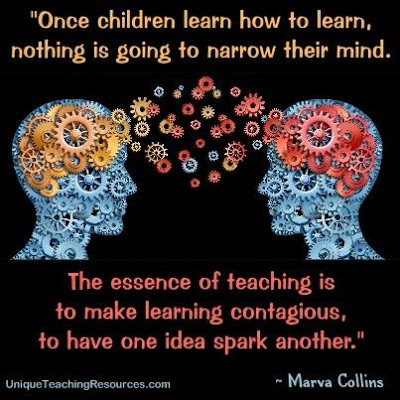
We now live and work in different times. Technology, the pursuit of innovation, and advancements in research have fundamentally changed the learning culture in many schools for the better. As I have conducted thousands of walk-throughs in schools, I am always looking at the convergence of instruction and learning. To me, instruction is what the adult does whereas learning is what the student does. There is some gray area here, but the overall goal is to continually grow by taking a critical lens to practice with the goal of improving learning outcomes for kids. With this being said, I have gone back to the ITIP Model and adapted it a bit. Some items remain, while a few others have been added.
Standards-aligned learning target
These frame the lesson from the students' point of view and are presented as “I can” or “I will” statements. They help kids grasp the lesson's purpose—why it is crucial to learn this concept, on this day, and in this way. Targets help to create an environment where kids exhibit more ownership over their learning. Critical questions framed from the lens of the learner include:
Why is this idea, topic, or subject vital for me to learn and understand so that I can do this? How will I show that I can do this, and how well will I have to do it?What will I be able to do when I've finished this lesson?
Anticipatory set
Anticipatory set is used to prepare learners for the lesson or task by setting their minds for instruction or learning. This is achieved by asking a question, adding a relevant context, or making statements to pique interest, create mental images, review information, and initiate the learning process. A good do-now activity can accomplish this.
Review prior learning
Research in cognitive science has shown that eliciting prior understandings is a necessary component of the learning process. Research also has shown that expert learners are much more adept at the transfer of learning than novices and that practice in the transfer of learning is required in good instruction (Bransford, Brown, and Cocking 2000).
Modeling
A pedagogical strategy where the teacher or student(s), demonstrates how to complete tasks and activities related to the learning target.
Check for understanding
Specific points during the lesson or task when the teacher checks to see if the students understand the concept or steps and how to enact them to achieve the target. It clarifies the purpose of the learning, can be leveraged as a mechanism for feedback and can provide valuable information that can be used to modify the lesson.
Practice
Guided practice is when the students engage in learning target activities under the guidance of a support system that can assure success. Independent practice is when the kids practice and reinforce what they learn after they are capable of performing the target without support.
Authentic application of learning
REAL learning in the classroom empowers students to manipulate the material to solve problems, answer questions, formulate questions of their own, discuss, explain, debate, or brainstorm. These activities deemphasize direct instruction and can include discussion questions and group exercises, as well as problem-posing and -solving sessions, to get the concepts across in a meaningful and memorable way. Pedagogical techniques such as personalized, blended and project-based learning as well as differentiated instruction and student agency can lead to greater ownership amongst learners.
Closure
Learning increases when lessons are concluded in a manner that helps students organize and remember the point of the lesson. Closure draws attention to the end of the lesson, helps students organize their learning, reinforces the significant points of the lesson, allows students to practice what is learned, and provides an opportunity for feedback and review.
Feedback
Verbal and non-verbal means to justify a grade, establish criteria for improvement, provide motivation for the next assessment, reinforce good work, and act as a catalyst for reflection. Feedback is valuable when it is received, understood and acted on (Nicol, 2010). How students analyze, discuss and act on feedback is as important as the quality of the feedback itself. Make sure it is Timely, specific to standard(s) and concept(s), constructive and meaningful. For more strategies on how to improve feedback click HERE.
Assessment
Well-designed assessment sets clear expectations, establishes a reasonable workload (one that does not push students into rote reproductive approaches to study), and provides opportunities for students to self-monitor, rehearse, practice and receive feedback. Assessment is an integral component of a coherent educational experience.
Not all of these strategies will be implemented in every lesson nor should they. However, each provides a lens to look at practice and make needed changes that can lead to better outcomes. It should also be noted that technology represents a natural pedagogical fit that can be used to implement these strategies with enhanced fidelity. Make the time to reflect daily as to where you are to get to where your learners want and need you to be.
Bransford, J. D., Brown, A. L., & Cocking, R. R. (2000). How People Learn: Brain, Mind, Experience, and School. Washington DC: National Academy Press.
Nicol, D. (2010). From monologue to dialogue: improving written feedback processes in mass higher education. Assessment & Evaluation in Higher Education, 35(5), 501-517.
Stockard, Jean & W. Wood, Timothy & Coughlin, Cristy & Rasplica Khoury, Caitlin. (2018). The Effectiveness of Direct Instruction Curricula: A Meta-Analysis of a Half Century of Research. Review of Educational Research: 88(4).
Many of the original tenets still have merit today. As a realist, there is still value in direct instruction. In his meta-analysis of over 300 research studies, John Hattie found that direct instruction has above average gains when it comes to student results, specifically an effect size of 0.59. Another meta-analysis on over 400 studies indicated strong positive results (Stockard et al., 2018). The effectiveness of this pedagogical technique relies on it being only a small component of a lesson. The rule of thumb during my days as a principal was for my teachers to limit any lecture component. Direct Instruction should be designed so that learners can construct (induce) concepts and generalizations. For example, lessons can be divided into short exercises (two to four minutes) on slightly different but related topics. This sustains children's interest level and facilitates children's synthesizing knowledge from different activities into a larger whole.

We now live and work in different times. Technology, the pursuit of innovation, and advancements in research have fundamentally changed the learning culture in many schools for the better. As I have conducted thousands of walk-throughs in schools, I am always looking at the convergence of instruction and learning. To me, instruction is what the adult does whereas learning is what the student does. There is some gray area here, but the overall goal is to continually grow by taking a critical lens to practice with the goal of improving learning outcomes for kids. With this being said, I have gone back to the ITIP Model and adapted it a bit. Some items remain, while a few others have been added.
Standards-aligned learning target
These frame the lesson from the students' point of view and are presented as “I can” or “I will” statements. They help kids grasp the lesson's purpose—why it is crucial to learn this concept, on this day, and in this way. Targets help to create an environment where kids exhibit more ownership over their learning. Critical questions framed from the lens of the learner include:
Why is this idea, topic, or subject vital for me to learn and understand so that I can do this? How will I show that I can do this, and how well will I have to do it?What will I be able to do when I've finished this lesson?
Anticipatory set
Anticipatory set is used to prepare learners for the lesson or task by setting their minds for instruction or learning. This is achieved by asking a question, adding a relevant context, or making statements to pique interest, create mental images, review information, and initiate the learning process. A good do-now activity can accomplish this.
Review prior learning
Research in cognitive science has shown that eliciting prior understandings is a necessary component of the learning process. Research also has shown that expert learners are much more adept at the transfer of learning than novices and that practice in the transfer of learning is required in good instruction (Bransford, Brown, and Cocking 2000).
Modeling
A pedagogical strategy where the teacher or student(s), demonstrates how to complete tasks and activities related to the learning target.
Check for understanding
Specific points during the lesson or task when the teacher checks to see if the students understand the concept or steps and how to enact them to achieve the target. It clarifies the purpose of the learning, can be leveraged as a mechanism for feedback and can provide valuable information that can be used to modify the lesson.
Practice
Guided practice is when the students engage in learning target activities under the guidance of a support system that can assure success. Independent practice is when the kids practice and reinforce what they learn after they are capable of performing the target without support.
Authentic application of learning
REAL learning in the classroom empowers students to manipulate the material to solve problems, answer questions, formulate questions of their own, discuss, explain, debate, or brainstorm. These activities deemphasize direct instruction and can include discussion questions and group exercises, as well as problem-posing and -solving sessions, to get the concepts across in a meaningful and memorable way. Pedagogical techniques such as personalized, blended and project-based learning as well as differentiated instruction and student agency can lead to greater ownership amongst learners.
Closure
Learning increases when lessons are concluded in a manner that helps students organize and remember the point of the lesson. Closure draws attention to the end of the lesson, helps students organize their learning, reinforces the significant points of the lesson, allows students to practice what is learned, and provides an opportunity for feedback and review.
Feedback
Verbal and non-verbal means to justify a grade, establish criteria for improvement, provide motivation for the next assessment, reinforce good work, and act as a catalyst for reflection. Feedback is valuable when it is received, understood and acted on (Nicol, 2010). How students analyze, discuss and act on feedback is as important as the quality of the feedback itself. Make sure it is Timely, specific to standard(s) and concept(s), constructive and meaningful. For more strategies on how to improve feedback click HERE.
Assessment
Well-designed assessment sets clear expectations, establishes a reasonable workload (one that does not push students into rote reproductive approaches to study), and provides opportunities for students to self-monitor, rehearse, practice and receive feedback. Assessment is an integral component of a coherent educational experience.
Not all of these strategies will be implemented in every lesson nor should they. However, each provides a lens to look at practice and make needed changes that can lead to better outcomes. It should also be noted that technology represents a natural pedagogical fit that can be used to implement these strategies with enhanced fidelity. Make the time to reflect daily as to where you are to get to where your learners want and need you to be.
Bransford, J. D., Brown, A. L., & Cocking, R. R. (2000). How People Learn: Brain, Mind, Experience, and School. Washington DC: National Academy Press.
Nicol, D. (2010). From monologue to dialogue: improving written feedback processes in mass higher education. Assessment & Evaluation in Higher Education, 35(5), 501-517.
Stockard, Jean & W. Wood, Timothy & Coughlin, Cristy & Rasplica Khoury, Caitlin. (2018). The Effectiveness of Direct Instruction Curricula: A Meta-Analysis of a Half Century of Research. Review of Educational Research: 88(4).
Published on September 30, 2018 05:39
September 23, 2018
The Pivotal Role Movement Plays in Learning
“More blood means more energy and oxygen, which makes our brain perform better.” – Justin Rhodes
Spending time in schools as a leadership and learning coach has been some of the most gratifying work I have done. The best part is the conversations that I get to have with learners, especially at the elementary level. These always leave me invigorated and remind me why I became a teacher many years ago. Then there is the practicality of being able to work with both administrators and teachers at the ground level to improve pedagogy and, in turn, student outcomes. From this lens, I get to truly see the seeds of change germinate into real shifts in practice. It also provides me with an opportunity to reflect on what I see and my take on how the field of education can continue to evolve in ways that better support the needs of all learners.
Case in point. Recently I was conducting learning walks in Edward K. Downing Elementary School with principal Marcos Lopez as part of some broader work in Ector County ISD. As we entered, the lesson was about to conclude. The teacher had the students engaged in a closure activity to demonstrate an understanding of multiplication concepts in math. After the exit tickets were all turned in the teacher had all the students participate in a brain break activity. Each kid was instructed to get up, walk around the room, and find a partner who was not in their pre-assigned seating groups. They were then instructed to compete in several games of rock-paper-scissors with various peers. After some heightened physical activity and fun, the lesson then transitioned to a do-now activity where students completed a science table to review prior learning.
At first, I was enamored by the concept of brain breaks. As a result, I did a little digging into the concept. Numerous studies have found that without breaks students have higher instances of inappropriate classroom behavior. Not only did Elisabeth Trambley (2017) do a fantastic literature review of these, but she also conducted her own research study to determine the impact of brain breaks on behavior. She found that once the breaks were implemented the inappropriate behavior diminished, establishing a functional relationship between breaks and classroom behavior.
The concept of brain breaks got me thinking about a growing trend in education – as kids progress through the K-12 system, there is less and less movement. I have seen this firsthand in schools across the globe. Let’s look into this a little more closely. Research reviewed by Elisabeth Trambley, Jacob Sattelmair & John Ratey (2009), and Kristy Ford (2016) all conclude how both recess and physical activity lead to improved learning outcomes. To go even a bit deeper, studies have found that movement improves overall learning as well as test scores, skills, and content knowledge in core subjects such as mathematics and reading fluency as well as increases student interest and motivation (Adams-Blair & Oliver, 2011; Braniff, 2011; Vazou et al., 2012; Erwin, Fedewa, & Ahn, 2013; Browning et al., 2014).
The bottom line is not only is physical education an absolute must in the K-12 curriculum, but schools need to do more to ensure that movement is being integrated into all classes. Need more proof on how important movement is? All one has to do for this is to turn to science. The brain needs regular stimulation to properly function and this can come in the form of exercise or movement. Based on what is now known about the brain, this has been shown to be an effective cognitive strategy to improve memory and retrieval, strengthen learning, and enhance motivation among all learners. The images below help to reinforce this point.
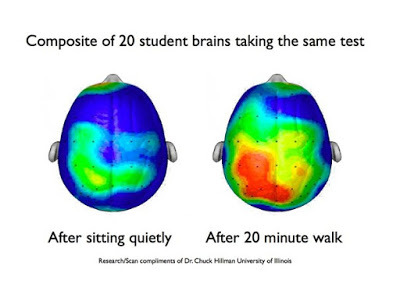 Click HERE to view the research study.
Click HERE to view the research study.
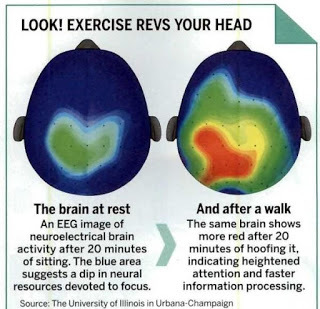
Science and research compel all educators to integrate more movement into the school day. Below is a short list of simple ideas to make this a reality.
Add more recess not just in elementary, but in middle school as well.Intentionally incorporate activities into each lesson regardless of the age of your students. Build in the time but don’t let the activity dictate what you are going to do. You need to read your learners and be flexible to determine the most appropriate activity. Implement short brain breaks from 30 seconds to 2 minutes in length every 20 minutes, or so that incorporate physical activity. If technology is available utilize GoNoodle, which is very popular as students rotate between stations in a blended learning environment. If not, no sweat. A practical activity can simply be getting students to walk in place or stand up and perform stretching routines. Ensure every student is enrolled in physical education during the school day.
Don’t look at kids moving in class as a break or poor use of instructional time. As research has shown, movement is an essential component of learning. If the goal is to help kids be better learners, then we have to be better at getting them up and moving in school.
Adams-Blair H., Oliver G. (2011). Daily classroom movement: Physical activity integration into the classroom. International Journal of Health, Wellness, & Society, 1 (3), 147–154.
Braniff C. (2011). Perceptions of an active classroom: Exploration of movement and collaboration with fourth grade students. Networks: An On-line Journal for Teacher Research, 13 (1).
Browning C., Edson A.J., Kimani P., Aslan-Tutak F. (2014). Mathematical content knowledge for teaching elementary mathematics: A focus on geometry and measurement. Mathematics Enthusiast, 11 (2), 333–383.
Erwin H., Fedewa A., Ahn S. (2013). Student academic performance outcomes of a classroom physical activity intervention: A pilot study. International Electronic Journal of Elementary Education, 5 (2), 109–124.
Spending time in schools as a leadership and learning coach has been some of the most gratifying work I have done. The best part is the conversations that I get to have with learners, especially at the elementary level. These always leave me invigorated and remind me why I became a teacher many years ago. Then there is the practicality of being able to work with both administrators and teachers at the ground level to improve pedagogy and, in turn, student outcomes. From this lens, I get to truly see the seeds of change germinate into real shifts in practice. It also provides me with an opportunity to reflect on what I see and my take on how the field of education can continue to evolve in ways that better support the needs of all learners.
Case in point. Recently I was conducting learning walks in Edward K. Downing Elementary School with principal Marcos Lopez as part of some broader work in Ector County ISD. As we entered, the lesson was about to conclude. The teacher had the students engaged in a closure activity to demonstrate an understanding of multiplication concepts in math. After the exit tickets were all turned in the teacher had all the students participate in a brain break activity. Each kid was instructed to get up, walk around the room, and find a partner who was not in their pre-assigned seating groups. They were then instructed to compete in several games of rock-paper-scissors with various peers. After some heightened physical activity and fun, the lesson then transitioned to a do-now activity where students completed a science table to review prior learning.
At first, I was enamored by the concept of brain breaks. As a result, I did a little digging into the concept. Numerous studies have found that without breaks students have higher instances of inappropriate classroom behavior. Not only did Elisabeth Trambley (2017) do a fantastic literature review of these, but she also conducted her own research study to determine the impact of brain breaks on behavior. She found that once the breaks were implemented the inappropriate behavior diminished, establishing a functional relationship between breaks and classroom behavior.
The concept of brain breaks got me thinking about a growing trend in education – as kids progress through the K-12 system, there is less and less movement. I have seen this firsthand in schools across the globe. Let’s look into this a little more closely. Research reviewed by Elisabeth Trambley, Jacob Sattelmair & John Ratey (2009), and Kristy Ford (2016) all conclude how both recess and physical activity lead to improved learning outcomes. To go even a bit deeper, studies have found that movement improves overall learning as well as test scores, skills, and content knowledge in core subjects such as mathematics and reading fluency as well as increases student interest and motivation (Adams-Blair & Oliver, 2011; Braniff, 2011; Vazou et al., 2012; Erwin, Fedewa, & Ahn, 2013; Browning et al., 2014).
The bottom line is not only is physical education an absolute must in the K-12 curriculum, but schools need to do more to ensure that movement is being integrated into all classes. Need more proof on how important movement is? All one has to do for this is to turn to science. The brain needs regular stimulation to properly function and this can come in the form of exercise or movement. Based on what is now known about the brain, this has been shown to be an effective cognitive strategy to improve memory and retrieval, strengthen learning, and enhance motivation among all learners. The images below help to reinforce this point.
 Click HERE to view the research study.
Click HERE to view the research study.
Science and research compel all educators to integrate more movement into the school day. Below is a short list of simple ideas to make this a reality.
Add more recess not just in elementary, but in middle school as well.Intentionally incorporate activities into each lesson regardless of the age of your students. Build in the time but don’t let the activity dictate what you are going to do. You need to read your learners and be flexible to determine the most appropriate activity. Implement short brain breaks from 30 seconds to 2 minutes in length every 20 minutes, or so that incorporate physical activity. If technology is available utilize GoNoodle, which is very popular as students rotate between stations in a blended learning environment. If not, no sweat. A practical activity can simply be getting students to walk in place or stand up and perform stretching routines. Ensure every student is enrolled in physical education during the school day.
Don’t look at kids moving in class as a break or poor use of instructional time. As research has shown, movement is an essential component of learning. If the goal is to help kids be better learners, then we have to be better at getting them up and moving in school.
Adams-Blair H., Oliver G. (2011). Daily classroom movement: Physical activity integration into the classroom. International Journal of Health, Wellness, & Society, 1 (3), 147–154.
Braniff C. (2011). Perceptions of an active classroom: Exploration of movement and collaboration with fourth grade students. Networks: An On-line Journal for Teacher Research, 13 (1).
Browning C., Edson A.J., Kimani P., Aslan-Tutak F. (2014). Mathematical content knowledge for teaching elementary mathematics: A focus on geometry and measurement. Mathematics Enthusiast, 11 (2), 333–383.
Erwin H., Fedewa A., Ahn S. (2013). Student academic performance outcomes of a classroom physical activity intervention: A pilot study. International Electronic Journal of Elementary Education, 5 (2), 109–124.
Published on September 23, 2018 05:25
September 16, 2018
5 Strategies to Create a Culture of Accountability for Growth
In a world where ideas are a dime a dozen and shared openly on social media, it is incumbent upon all of us to critically reflect and determine if it is, in fact, a sound strategy. Anyone who reads my blog knows that I am a huge proponent of research-influenced practice, evidence, accountability, and efficacy. During workshops with administrators and teachers, I get to dive deep into these topics and outline the strategies that schools use to improve outcomes. In my opinion, this isn’t even really a debate for anyone that has worked in a school where outcomes were improved. As any practitioner knows this is not the end or be all, but the reality is that results don’t come from pie in the sky sound bites. Thus, improvement relies on an honest assessment of where current practice resides and making the necessary changes to move to where we need to be.
Let’s begin with this. If you are an administrator, do you know what is going on in your classrooms? I for one did not know this for a while until we began to focus on ensuring a Return on Instruction (ROI). It is hard to fix an issue if you don’t know it exists. The same could be said about commending and then sharing effective strategies. We don’t know what we don’t know. Getting into classrooms more can be one of the most important decisions you make. If you are a teacher or coach, how often do you receive formal feedback on your practice and are given time to work on areas to improve upon? The only way to scale growth is to ensure that accountability structures are in place. Formal observations are one means to help accomplish this. These differ from walk-throughs, as they are evaluative whereas learning walks are most often non-evaluative.
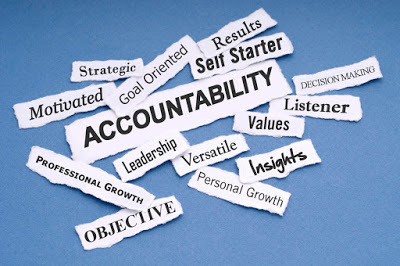 Image credit
Image credit
The primary purpose of an observation is to help teachers, coaches, administrators, and other staff improve through connections to research-based practices, data analysis, good feedback, and reflection. A good observation is all about growth. They became ineffective when used as an “I gotcha” moment or provide no real strategies to improve. Let me expand on the latter part of the last sentence. There is no perfect lesson, project, teacher, or administrator. Herein lies my crucial point. No matter where an educator is in their career and regardless of experience, there is always room for growth and the majority of educators are more than open to this. Accountability for this has to be emphasized either through self-efficacy or sound observation techniques.
Everyone can benefit from good feedback. The question is how do you determine if that feedback has been reflected upon and used to improve practice? Taking a critical lens to your observation protocols can go a long way to ensuring efficacy by raising the bar across your system. Claims of good and better have merit when supported with actual observations and evidence that this is, in fact, the case. This is what instructional leadership is all about. Below are some strategies that I utilized to help create a culture where there was accountability for growth. Please note that not every contact point or conversation has to be evaluative. In the end, though, some people won’t respond to non-evaluative measures. Consistency is key.
Get in classrooms more. Regardless of your role, commit to watching the practice of others to inform your own or to provide feedback later. Make it a priority. Develop a daily schedule that consists of a combination of walk-throughs (non-evaluative) and formal observations (evaluative) and stick to it. We formally observed each staff member unannounced three times a year regardless of experience. This meant I had to not only build time into my schedule to conduct the observations but also to write them up. That’s why I always blocked off the following period after an observation so that I could write it up.Streamline the process as best you can. I created a template for myself and my admin team to use during observations. This allowed each of us to script by standard while also ensuring that the most essential sub-standards were front and center. You can view the template HERE. Note that this template was nowhere near as detailed as the actual tool uses, but it did greatly assist with the write-up process afterward. I also curated a document that had comments ready to go aligned to sound pedagogical practice and research where applicable. Provide timely and specific feedback, but also make sure to follow-up with more walks and observations to ensure that the feedback was reflected and acted upon. I made it a point to conduct each observation post-conference the very next school day. Create mechanisms for educators to share work through artifacts and portfolios. You can’t see everything during a walk-through or observation nor can you be everywhere all the time. These can be used to support what you don’t see during observations or to add more context. They can also be integrated as a way to add more substance and authenticity to mid and end of year evaluations.
Complacency and mediocrity are a choice for many people. So is choosing to get better each day. The choice is yours. Every educator is ultimately accountable to the learners they serve. Thus, there is no real choice in this matter. Accountability should not be feared or frowned upon. It is prevalent in virtually every job sector as a means to improve performance. When focused on promoting growth, accountability can help to create a culture of excellence while helping all learners achieve success.
Let’s begin with this. If you are an administrator, do you know what is going on in your classrooms? I for one did not know this for a while until we began to focus on ensuring a Return on Instruction (ROI). It is hard to fix an issue if you don’t know it exists. The same could be said about commending and then sharing effective strategies. We don’t know what we don’t know. Getting into classrooms more can be one of the most important decisions you make. If you are a teacher or coach, how often do you receive formal feedback on your practice and are given time to work on areas to improve upon? The only way to scale growth is to ensure that accountability structures are in place. Formal observations are one means to help accomplish this. These differ from walk-throughs, as they are evaluative whereas learning walks are most often non-evaluative.
 Image credit
Image creditThe primary purpose of an observation is to help teachers, coaches, administrators, and other staff improve through connections to research-based practices, data analysis, good feedback, and reflection. A good observation is all about growth. They became ineffective when used as an “I gotcha” moment or provide no real strategies to improve. Let me expand on the latter part of the last sentence. There is no perfect lesson, project, teacher, or administrator. Herein lies my crucial point. No matter where an educator is in their career and regardless of experience, there is always room for growth and the majority of educators are more than open to this. Accountability for this has to be emphasized either through self-efficacy or sound observation techniques.
Everyone can benefit from good feedback. The question is how do you determine if that feedback has been reflected upon and used to improve practice? Taking a critical lens to your observation protocols can go a long way to ensuring efficacy by raising the bar across your system. Claims of good and better have merit when supported with actual observations and evidence that this is, in fact, the case. This is what instructional leadership is all about. Below are some strategies that I utilized to help create a culture where there was accountability for growth. Please note that not every contact point or conversation has to be evaluative. In the end, though, some people won’t respond to non-evaluative measures. Consistency is key.
Get in classrooms more. Regardless of your role, commit to watching the practice of others to inform your own or to provide feedback later. Make it a priority. Develop a daily schedule that consists of a combination of walk-throughs (non-evaluative) and formal observations (evaluative) and stick to it. We formally observed each staff member unannounced three times a year regardless of experience. This meant I had to not only build time into my schedule to conduct the observations but also to write them up. That’s why I always blocked off the following period after an observation so that I could write it up.Streamline the process as best you can. I created a template for myself and my admin team to use during observations. This allowed each of us to script by standard while also ensuring that the most essential sub-standards were front and center. You can view the template HERE. Note that this template was nowhere near as detailed as the actual tool uses, but it did greatly assist with the write-up process afterward. I also curated a document that had comments ready to go aligned to sound pedagogical practice and research where applicable. Provide timely and specific feedback, but also make sure to follow-up with more walks and observations to ensure that the feedback was reflected and acted upon. I made it a point to conduct each observation post-conference the very next school day. Create mechanisms for educators to share work through artifacts and portfolios. You can’t see everything during a walk-through or observation nor can you be everywhere all the time. These can be used to support what you don’t see during observations or to add more context. They can also be integrated as a way to add more substance and authenticity to mid and end of year evaluations.

Complacency and mediocrity are a choice for many people. So is choosing to get better each day. The choice is yours. Every educator is ultimately accountable to the learners they serve. Thus, there is no real choice in this matter. Accountability should not be feared or frowned upon. It is prevalent in virtually every job sector as a means to improve performance. When focused on promoting growth, accountability can help to create a culture of excellence while helping all learners achieve success.
Published on September 16, 2018 05:39
September 9, 2018
The Purpose of Content
When I think back to my days as a learner, the content seemed to be at the forefront of every class. Whether it was disseminated during a lecture in college, through direct instruction in K-12, or at times consumed from a textbook or encyclopedia, it was everywhere. The more I think about it; content was predominately the focus in every class. Day in and day out a repetitive cycle ensued in most classes where my classmates and I were given information and then tasked with demonstrating what we learned, or in a few cases, constructing new knowledge. The bottom line is that I, like many other students at the time, did school and never really questioned the means or process. In the end, it was about passing the test plain and simple.
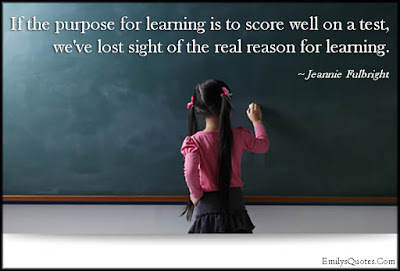
Now I am not saying that content is not valuable or not needed as a basis to move from low to high-level learning. It goes without saying that a certain amount of content is required like learning letters and numbers to be able to move to different levels of knowledge construction in language arts and mathematics respectively. But let’s face it, as learners progress through the system, content, and knowledge for that matter can be easily accessed using a variety of mobile devices. This then begs the question – how relevant is content really in a knowledge-based economy that continues to evolve exponentially thanks to advances in technology?
When reflecting on the last question in the paragraph above, I think about the following quote from Steve Revington, “Content without purpose is only trivia.” Learners today are not as compliant or conforming as many of us were back in the day nor should they be. Whether we are talking about authentic or relevant learning, kids inherently want to know what the higher purpose is and who can blame them.
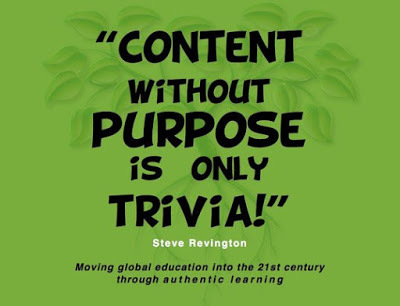
When content has a purpose and is applied in relevant ways to construct new knowledge, learners will be able to tell you:
What they learnedWhy the learned itHow they will use it both in and out of schoolA lesson, project, or activity that is relevant and has purpose allows learners to use both the content and their knowledge to tackle real-world problems that have more than one solution. The shift here is key. Engagement for learning empowers kids to put knowledge to use, not just acquire it for its own sake. Many yearn for and deserve to use content and acquired knowledge to solve complex, real-world problems and create projects, designs, and other works for use in real-world situations. The value in content relies on how it is applied to develop thinking in a purposeful way further.
Being a whiz at trivia might help as a contestant on Jeopardy but has little value in the game of life. The stakes are now higher, which means we must take a critical lens to our work to grow and improve. Helping our learners find greater purpose is something I think we can all agree on and will benefit them well into the future.

Now I am not saying that content is not valuable or not needed as a basis to move from low to high-level learning. It goes without saying that a certain amount of content is required like learning letters and numbers to be able to move to different levels of knowledge construction in language arts and mathematics respectively. But let’s face it, as learners progress through the system, content, and knowledge for that matter can be easily accessed using a variety of mobile devices. This then begs the question – how relevant is content really in a knowledge-based economy that continues to evolve exponentially thanks to advances in technology?
When reflecting on the last question in the paragraph above, I think about the following quote from Steve Revington, “Content without purpose is only trivia.” Learners today are not as compliant or conforming as many of us were back in the day nor should they be. Whether we are talking about authentic or relevant learning, kids inherently want to know what the higher purpose is and who can blame them.

When content has a purpose and is applied in relevant ways to construct new knowledge, learners will be able to tell you:
What they learnedWhy the learned itHow they will use it both in and out of schoolA lesson, project, or activity that is relevant and has purpose allows learners to use both the content and their knowledge to tackle real-world problems that have more than one solution. The shift here is key. Engagement for learning empowers kids to put knowledge to use, not just acquire it for its own sake. Many yearn for and deserve to use content and acquired knowledge to solve complex, real-world problems and create projects, designs, and other works for use in real-world situations. The value in content relies on how it is applied to develop thinking in a purposeful way further.
Being a whiz at trivia might help as a contestant on Jeopardy but has little value in the game of life. The stakes are now higher, which means we must take a critical lens to our work to grow and improve. Helping our learners find greater purpose is something I think we can all agree on and will benefit them well into the future.
Published on September 09, 2018 05:37
September 2, 2018
Who Should Facilitate Professional Learning?
Have you ever paid money to go and watch a professional sporting event, play, or musical? Your answer is probably a resounding yes. If you are like me, then you have gone too many times to count and have lost track. What drives you to spend money and attend these events? More than likely you go to watch the athletes compete or artists perform. In some cases, you participated in these activities at a certain level during your lifetime. Or maybe you are just passionate about and moved by, how the experience makes you feel. Regardless of your rationale, it is essential to understand that there is so much going on behind the scenes leading up to the culminating event that you pay to watch.
Let me focus the rest of my point on professional sports. For countless hours each athlete is coached, taught, and guided by numerous individuals who have some direct experience in the sport. These individuals either excelled at some level, whether professional or collegiate, or they are a master teacher when it comes to knowledge, ideas, and strategy as to how to take a group of individuals and help them succeed as a team. The majority of these coaches possess a track record of success and the evidence to back it up. Why else would these people be employed to coach in the first place?
The kicker here though is that many of these coaches have not played the game in years, even decades. Take Nick Saban for example. Currently, he is paid millions of dollars (a little over eleven to be exact) as the head coach of the Alabama Crimson Tide football team. As the head coach, he ultimately calls the shots while training both players and assistant coaches alike. He has had unprecedented success developing players and building a football dynasty that others hope to emulate yet has not played a single snap of collegiate football since 1972 when he was on the team at Kent State University. Right after graduating in 1973 he became an assistant coach at Kent State. Approximately 45 years later he is still at it. This begs the question, which we all know the answer. Had not playing the game in decades hindered his ability to help others achieve impressive results?
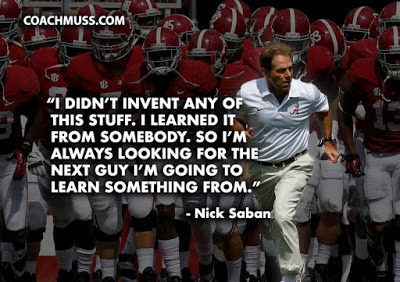
There is often a debate in physical and virtual spaces about who should facilitate professional learning for educators. I see and appreciate the points from both sides. Many people want current practitioners who can directly relate to either the content or responsibilities of the position. In a perfect world this would be great as well as ideal, but just like it is unrealistic for current players to coach, the same can be said for practicing educators, especially when the research has shown that on-going, job-embedded professional learning is what leads to improved learning outcomes. Quality professional learning takes time and goes well beyond one and done. It involves a critical lens, lack of bias, modeling, and meaningful feedback to drive growth.
Saban was a smart player who initially played offense but was later moved to defense. He was also part of a championship team during his playing days and has led teams he has coached to six college championships. The point here is that experience and outcomes matter. That is what all educators expect and deserve when it comes to professional learning. The key is to find the right consultants to help move you forward. When investing in any professional learning options do your research! Below are some questions that might help you with this:
How does the organization or consultant’s experience align with our intended outcomes? It is crucial that each have the appropriate experiences to facilitate the work.Does the organization or consultant have evidence of success when it comes to improving outcomes? What criteria make them the best to facilitate the work? Just like I did a Google search on Nick Saban, you can do the same when it comes to companies and consultants. How can an outsider’s view move us forward by helping us see what we are missing? It is often difficult to move beyond internal bias. Sometimes a different relationship and lens are needed to move systems forward. This is where outside consultants can help.Is the intended work aligned to research and evidence on what works? In more blunt terms, have they implemented what they are going to train you on? Effective professional learning moves beyond the fluff and broad claims.
Effective Professional Learning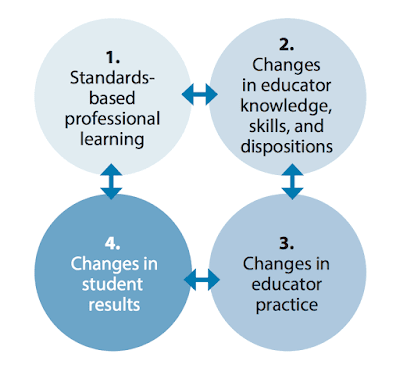 image credit
image credit
Important decisions have to be made when it comes to facilitating professional learning whether it is a workshop, keynote, or something more intensive like job-embedded coaching. As goals and outcomes are fleshed out, it is then incumbent to determine who is best to oversee the work, whether it is a practicing educator, in-house personnel, or an outside consultant. The lesson learned from the story of Nick Saban is that it behooves us not just to write someone off because they are not currently in a classroom or working in a school.
Substance matters.
Context matters.
Experience matters.
Professional learning is and should be an experience, not just an event. Satisfaction lies not only in having a message that resonates but how the work leads to improvements in teaching, learning, and leadership that are supported by a broad base of research and backed up by actual evidence of better outcomes. Don’t be so quick to judge based on someone’s current position. Do your homework and take a critical lens to their body of work to find the best fit to facilitate professional learning.
Let me focus the rest of my point on professional sports. For countless hours each athlete is coached, taught, and guided by numerous individuals who have some direct experience in the sport. These individuals either excelled at some level, whether professional or collegiate, or they are a master teacher when it comes to knowledge, ideas, and strategy as to how to take a group of individuals and help them succeed as a team. The majority of these coaches possess a track record of success and the evidence to back it up. Why else would these people be employed to coach in the first place?
The kicker here though is that many of these coaches have not played the game in years, even decades. Take Nick Saban for example. Currently, he is paid millions of dollars (a little over eleven to be exact) as the head coach of the Alabama Crimson Tide football team. As the head coach, he ultimately calls the shots while training both players and assistant coaches alike. He has had unprecedented success developing players and building a football dynasty that others hope to emulate yet has not played a single snap of collegiate football since 1972 when he was on the team at Kent State University. Right after graduating in 1973 he became an assistant coach at Kent State. Approximately 45 years later he is still at it. This begs the question, which we all know the answer. Had not playing the game in decades hindered his ability to help others achieve impressive results?

There is often a debate in physical and virtual spaces about who should facilitate professional learning for educators. I see and appreciate the points from both sides. Many people want current practitioners who can directly relate to either the content or responsibilities of the position. In a perfect world this would be great as well as ideal, but just like it is unrealistic for current players to coach, the same can be said for practicing educators, especially when the research has shown that on-going, job-embedded professional learning is what leads to improved learning outcomes. Quality professional learning takes time and goes well beyond one and done. It involves a critical lens, lack of bias, modeling, and meaningful feedback to drive growth.
Saban was a smart player who initially played offense but was later moved to defense. He was also part of a championship team during his playing days and has led teams he has coached to six college championships. The point here is that experience and outcomes matter. That is what all educators expect and deserve when it comes to professional learning. The key is to find the right consultants to help move you forward. When investing in any professional learning options do your research! Below are some questions that might help you with this:
How does the organization or consultant’s experience align with our intended outcomes? It is crucial that each have the appropriate experiences to facilitate the work.Does the organization or consultant have evidence of success when it comes to improving outcomes? What criteria make them the best to facilitate the work? Just like I did a Google search on Nick Saban, you can do the same when it comes to companies and consultants. How can an outsider’s view move us forward by helping us see what we are missing? It is often difficult to move beyond internal bias. Sometimes a different relationship and lens are needed to move systems forward. This is where outside consultants can help.Is the intended work aligned to research and evidence on what works? In more blunt terms, have they implemented what they are going to train you on? Effective professional learning moves beyond the fluff and broad claims.
Effective Professional Learning
 image credit
image creditImportant decisions have to be made when it comes to facilitating professional learning whether it is a workshop, keynote, or something more intensive like job-embedded coaching. As goals and outcomes are fleshed out, it is then incumbent to determine who is best to oversee the work, whether it is a practicing educator, in-house personnel, or an outside consultant. The lesson learned from the story of Nick Saban is that it behooves us not just to write someone off because they are not currently in a classroom or working in a school.
Substance matters.
Context matters.
Experience matters.
Professional learning is and should be an experience, not just an event. Satisfaction lies not only in having a message that resonates but how the work leads to improvements in teaching, learning, and leadership that are supported by a broad base of research and backed up by actual evidence of better outcomes. Don’t be so quick to judge based on someone’s current position. Do your homework and take a critical lens to their body of work to find the best fit to facilitate professional learning.
Published on September 02, 2018 05:57
August 26, 2018
A Picture is Worth a Thousand Words
In the past, I have written about my journey from digital nomad and detractor to leader. The catalyst for this transformation came in part from Twitter. My experiences in this social space forced me to take a critical lens to my professional practice as well as that of my staff in my school. Over time my primary use of social media shifted from communicator to learner. It was this shift that got me thinking about how tools could be used to amplify the fantastic work of my teachers, administrators, and students to showcase efficacy in improving school culture. It all comes down to this. If you don’t tell your story, then someone else will. I learned quickly that it was in our best interests to be proactive in this endeavor.
My strategy was to implement a multi-faceted approach that utilized a variety of tools beyond just Twitter and single media sources with the ultimate goal of sharing and engaging more with stakeholders. The digital world allows all educators to become the storyteller-in-chief, something that I first discussed in detail in Digital Leadership years ago. In both BrandED and Learning Transformed, the concept of building better relationships as a result of improved community engagement was discussed through both a research and innovative practice lens. Along with video, pictures were one of the most potent artifacts that I used to tell our story through greater context. Apparently, there was a reason for this. Take a look at the visuals below, and you will see very quickly why my first inclination was to capture an image and then share using a variety of options.
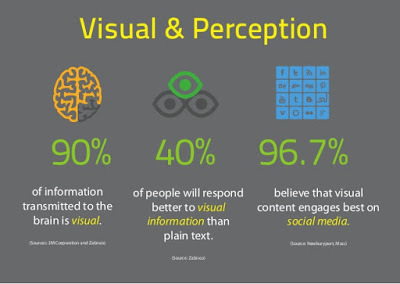 Image credit
Image credit
 Image credit
Image credit
Each picture provided a more detailed look at how our learners were purposefully using technology to either support or enhance learning. They also were used to showcase how my staff was effectively integrating innovative practices to improve learning outcomes. In other cases, images painted a picture of how our students were serving others in the local community and beyond. Contrary to popular belief, Twitter was not my preferred storytelling tool as a principal. This designation went to Instagram. With this tool, I could quickly snap a picture, add a caption or context, and then not only share here but also to Twitter and Facebook. Hashtags were used to amplify locally, nationally, and globally. With Instagram having over one billion users it makes perfect sense that this platform should be at the center of all sharing efforts. On a side note, you can check out my Instagram account HERE.
One of the most important decisions I made early on during our digital transformation was to get into classrooms more to conduct observations, walk-throughs, and provide better feedback to my teachers. A commitment to instructional leadership helped pave the way to improving learning outcomes across the school. I quickly seized on the opportunity of being in classrooms more by talking to learners and taking pictures of their work. In a matter of seconds after leaving a room, I was able to share the pictures on social media. Many of these became the catalyst for more detailed blog posts that illustrated how theory and research were being implemented in a way that led to evidence of better results.

Regardless of your position, you can use pictures to showcase the greatness that happens in classrooms, schools, and districts across the globe. I took pictures of everything, including plaques hanging in our hallways that celebrated impressive accomplishments relating to student achievement. Below is a quick list that can guide your image taking and sharing strategy:
Innovative practices: These can be pedagogical or even learning spaces. The key is to add context as to how these practices are leading to improvements in outcomes.Artifacts: As a job-embedded coach I am always taking pictures of student work across all disciplines, assessments, what kids are doing on devices, and any tangible item that illustrates good practice.Student achievement gains: It is important to share all types of success, including this. Plaques, banners, newspaper articles all make for powerful pictures that can be quickly shared.Culture: Everything that falls between, around, or outside classrooms and school that depicts how the needs of the whole child are being met make for compelling pictures. Pep rallies, staff comradery, service projects, internship experiences, capstone projects, and field trips are just a small sampling of what can be shared to illustrate a thriving school culture.As the title of this post implies, a picture is worth a thousand words and our brain loves them. How good is your current strategy at taking advantage of this?
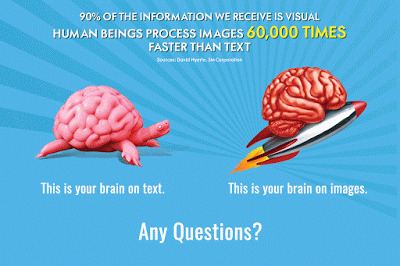 Image credit
Image credit
My strategy was to implement a multi-faceted approach that utilized a variety of tools beyond just Twitter and single media sources with the ultimate goal of sharing and engaging more with stakeholders. The digital world allows all educators to become the storyteller-in-chief, something that I first discussed in detail in Digital Leadership years ago. In both BrandED and Learning Transformed, the concept of building better relationships as a result of improved community engagement was discussed through both a research and innovative practice lens. Along with video, pictures were one of the most potent artifacts that I used to tell our story through greater context. Apparently, there was a reason for this. Take a look at the visuals below, and you will see very quickly why my first inclination was to capture an image and then share using a variety of options.
 Image credit
Image credit Image credit
Image creditEach picture provided a more detailed look at how our learners were purposefully using technology to either support or enhance learning. They also were used to showcase how my staff was effectively integrating innovative practices to improve learning outcomes. In other cases, images painted a picture of how our students were serving others in the local community and beyond. Contrary to popular belief, Twitter was not my preferred storytelling tool as a principal. This designation went to Instagram. With this tool, I could quickly snap a picture, add a caption or context, and then not only share here but also to Twitter and Facebook. Hashtags were used to amplify locally, nationally, and globally. With Instagram having over one billion users it makes perfect sense that this platform should be at the center of all sharing efforts. On a side note, you can check out my Instagram account HERE.
One of the most important decisions I made early on during our digital transformation was to get into classrooms more to conduct observations, walk-throughs, and provide better feedback to my teachers. A commitment to instructional leadership helped pave the way to improving learning outcomes across the school. I quickly seized on the opportunity of being in classrooms more by talking to learners and taking pictures of their work. In a matter of seconds after leaving a room, I was able to share the pictures on social media. Many of these became the catalyst for more detailed blog posts that illustrated how theory and research were being implemented in a way that led to evidence of better results.

Regardless of your position, you can use pictures to showcase the greatness that happens in classrooms, schools, and districts across the globe. I took pictures of everything, including plaques hanging in our hallways that celebrated impressive accomplishments relating to student achievement. Below is a quick list that can guide your image taking and sharing strategy:
Innovative practices: These can be pedagogical or even learning spaces. The key is to add context as to how these practices are leading to improvements in outcomes.Artifacts: As a job-embedded coach I am always taking pictures of student work across all disciplines, assessments, what kids are doing on devices, and any tangible item that illustrates good practice.Student achievement gains: It is important to share all types of success, including this. Plaques, banners, newspaper articles all make for powerful pictures that can be quickly shared.Culture: Everything that falls between, around, or outside classrooms and school that depicts how the needs of the whole child are being met make for compelling pictures. Pep rallies, staff comradery, service projects, internship experiences, capstone projects, and field trips are just a small sampling of what can be shared to illustrate a thriving school culture.As the title of this post implies, a picture is worth a thousand words and our brain loves them. How good is your current strategy at taking advantage of this?
 Image credit
Image credit
Published on August 26, 2018 05:52
August 19, 2018
The Case for Coaching Leaders
Growing up as a child I played numerous sports recreationally and in high school. Upon entering high school I was not the best athlete by any means, but football was one sport where I excelled more than others, and this led to some time playing in college. Even though I had some fantastic coaches throughout my days playing competitive sports, I never gave much thought to becoming one myself. Once I knew that my destiny was to become a teacher that was my sole focus. However, weeks before I was set to begin in my first role I was contacted by one of my former high school football coaches pleading with me to take the open freshman team role. Initially, I resisted but then decided that this could be an excellent opportunity to connect with more kids and hopefully in the process pass along some of the life lessons that I learned from my former coaches.
I loved coaching football and eventually took on the freshman lacrosse and head ice hockey positions in my school. For years I was able to teach both in the classroom and on the field. That is one of the critical points of this post. In many aspects, coaching is teaching, but without formal grades. As a coach, I provided lessons and strategies on skill development as well as competencies that pertained to excelling at a particular sport. Each practice involved modeling, guided practice, and either individual or team practice. At the end of each practice, there was a closure activity where we reflected on the events of that day while preparing for a future contest. The actual game was more or less an assessment of what my players had learned during practice.
Coaching is so much more than the result of a game, match, or competition. It is really about helping kids develop many of the qualities and characteristics in life that cannot be measured with an actual number such as leadership, commitment, perseverance, motivation, self-discipline, teamwork, resilience, enthusiasm, and reliability. The positive impact of a good coach can be felt for years and lead to success in both professional and personal aspects of life.
When we reflect on some of the outcomes I have listed above, it is apparent how important the act of coaching is in numerous professions, not just in athletics. Many school districts invest in instructional and digital coaches to assist teachers in further developing pedagogical capacity in these respective areas. This is a sound investment indeed, but research from the Wallace Foundation empowers schools to expand support to a group that is most often left out – leaders. In a recent article Marta Aldrich looked at a few studies highlighted below:
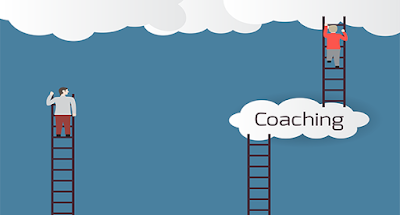 Image credit
Image credit
I encourage you to take a look at the links to the research from the Wallace Foundation for more detail on the why and how of coaching leaders. Peter DeWitt outlines some other key considerations when it comes to coaching leaders.
In any case, coaching can lead to improvements in teaching, learning, and leadership. These results are not isolated to just achievement data, but also to the many qualities and characteristics mentioned earlier in this post that cannot (and should not) be measured with a number. If the goal is to support our teachers better then commitments must be made to ramp up assistance to all school leaders, including central office. Investing time and resources in people, regardless of position, is the key to transforming school culture in a way that leads to better results.
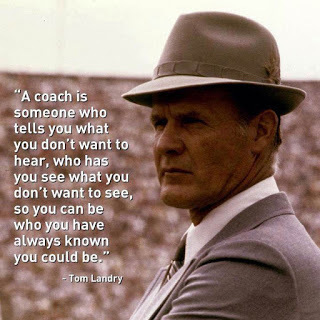
A great deal of my work as of late with districts, schools, and organizations has been in the role of job-embedded coach. If you are interested in learning more about what this looks like shoot me an email (esheninger@gmail.com).
I loved coaching football and eventually took on the freshman lacrosse and head ice hockey positions in my school. For years I was able to teach both in the classroom and on the field. That is one of the critical points of this post. In many aspects, coaching is teaching, but without formal grades. As a coach, I provided lessons and strategies on skill development as well as competencies that pertained to excelling at a particular sport. Each practice involved modeling, guided practice, and either individual or team practice. At the end of each practice, there was a closure activity where we reflected on the events of that day while preparing for a future contest. The actual game was more or less an assessment of what my players had learned during practice.
Coaching is so much more than the result of a game, match, or competition. It is really about helping kids develop many of the qualities and characteristics in life that cannot be measured with an actual number such as leadership, commitment, perseverance, motivation, self-discipline, teamwork, resilience, enthusiasm, and reliability. The positive impact of a good coach can be felt for years and lead to success in both professional and personal aspects of life.
When we reflect on some of the outcomes I have listed above, it is apparent how important the act of coaching is in numerous professions, not just in athletics. Many school districts invest in instructional and digital coaches to assist teachers in further developing pedagogical capacity in these respective areas. This is a sound investment indeed, but research from the Wallace Foundation empowers schools to expand support to a group that is most often left out – leaders. In a recent article Marta Aldrich looked at a few studies highlighted below:
When it comes to the impact of school-related factors on student learning, research shows that school leaders are second in importance only to teachers — but also can have a multiplier effect on the quality of teaching. Historically, however, professional development has been limited to periodic workshops and training that focus mostly on administrative, operational, and compliance issues. They rarely receive ongoing, embedded coaching and problem-solving support based on the instructional needs of specific schools.Leaders need consistent support and feedback on all aspects of the position to continually grown and improve, but the most emphasis should be on issues related to instructional leadership. If teachers are being coached on research-based instruction and digital pedagogy for example, then leaders need to be well equipped to provide useful feedback and conduct effective observations or evaluations. The same can be said about PLC’s, use of data, meeting the needs of learners with special needs, innovative practices, space redesign, etc.
 Image credit
Image creditI encourage you to take a look at the links to the research from the Wallace Foundation for more detail on the why and how of coaching leaders. Peter DeWitt outlines some other key considerations when it comes to coaching leaders.
One of the issues with any type of coaching, and something I found in a small-scale study I did with a little over 250 participating principals, was when principals felt coaching was focused on their needs and remained confidential, as opposed to focusing solely on the needs of the district, it was beneficial to their growth. Leaders, like teachers, need to feel that there is trust when it comes to working with a coach. Additionally, leadership coaching is only an effective means of professional development when it has the following elements of effective professional development:
Happens over an extended period of time
Involves external experts
Teachers/Leaders are deeply engaged
It challenges existing beliefs (Timperely et al. 2007).Research has consistently shown that professional learning that leads to school improvement and meaningful changes to practice is ongoing and job-embedded. It is incumbent upon organizations, boards of education, and school districts to commit to helping teachers and leaders through effective coaching practices. Larger organizations and districts might be able to make it work within existing structures, but this does not eliminate some of the inherent bias and trust issues that will still exist. Being coached by the person who will eventually evaluate your performance might not always lead to a trusting relationship. It is also important to have coaches that possess the practical experience aligned with the areas where a leader can benefit from job-embedded coaching.
In any case, coaching can lead to improvements in teaching, learning, and leadership. These results are not isolated to just achievement data, but also to the many qualities and characteristics mentioned earlier in this post that cannot (and should not) be measured with a number. If the goal is to support our teachers better then commitments must be made to ramp up assistance to all school leaders, including central office. Investing time and resources in people, regardless of position, is the key to transforming school culture in a way that leads to better results.

A great deal of my work as of late with districts, schools, and organizations has been in the role of job-embedded coach. If you are interested in learning more about what this looks like shoot me an email (esheninger@gmail.com).
Published on August 19, 2018 05:32
August 12, 2018
Student Agency is More Than Voice and Choice
Educators and schools across the globe have embraced the concept of student agency. It is a relatively simple concept in theory, but much more difficult to implement in practice. The underlying premise is to move learners from a state of engagement to empowerment so that they exert more ownership over their learning. For many schools, this flies in the face of a traditional schooling mindset that was more geared to learners having to buy-in to a one-size-fits-all system where success was determined by how well everyone did under the same conditions more or less. Oh, wait…. this is still the case in many schools. I digress. A culture that embraces student agency promotes risk-taking while working to remove the fear of failure helps students develop a growth mindset, and has students applying what they have learned in real-world contexts as opposed to just in the classroom.
Student agency is all about improving the learning experience for kids. The most common strategy that is embraced in schools is empowering learners through voice and choice. This could come in the form of kids selecting the right tool for the right task to demonstrate conceptual mastery or choosing where to sit in a classroom with flexible seating. It might be facilitated by posing questions and then having students respond under cover of anonymity using mobile devices. Or maybe it is combining both elements of voice and choice through pedagogically sound blended learning activities. Learning in and out of the classroom should always be at the forefront when it comes to agency. However, we must not lose sight of the third element that comprises this concept, and that is advocacy.
 Image credit: https://addictionandrecoverynews.word...
Image credit: https://addictionandrecoverynews.word...
While voice and choice are more aligned with ownership of learning in the classroom, advocacy aligns with improving the school or district culture. Learners should be in a position to advocate for ideas, strategies, resources, and other elements that will help them succeed. This is not a new concept in any sense. Adam Fletcher writes:
When hiring new teachers and administrators include students on the panel for the first round of interviews.If you make a move to Bring Your Own Device (BYOD) or 1:1 elicit input from students when crafting policies and expectations.To start the school year, allow students to co-create classroom rules.When looking to improve divisive topics such as grading and homework allow students to weigh in and offer suggestions.Empower students to use social media and the school newspaper or magazine to engage in respectful dialogue about how to improve culture.As you either create or refine your makerspace, gather student input on what themes, tools, and technology they would like to haveEnsure there is a student representative to the local Board of Education (BOE) and Parent Teacher Organization (PTO)
Student agency can be a powerful force in education. It can increase the degree of autonomy and self-determination amongst our learners while also engaging them in activities which aim to influence decisions in a school or district. How are or will you integrate more opportunities for advocacy to create a learning culture that prioritizes all elements of student agency?
Student agency is all about improving the learning experience for kids. The most common strategy that is embraced in schools is empowering learners through voice and choice. This could come in the form of kids selecting the right tool for the right task to demonstrate conceptual mastery or choosing where to sit in a classroom with flexible seating. It might be facilitated by posing questions and then having students respond under cover of anonymity using mobile devices. Or maybe it is combining both elements of voice and choice through pedagogically sound blended learning activities. Learning in and out of the classroom should always be at the forefront when it comes to agency. However, we must not lose sight of the third element that comprises this concept, and that is advocacy.
 Image credit: https://addictionandrecoverynews.word...
Image credit: https://addictionandrecoverynews.word...While voice and choice are more aligned with ownership of learning in the classroom, advocacy aligns with improving the school or district culture. Learners should be in a position to advocate for ideas, strategies, resources, and other elements that will help them succeed. This is not a new concept in any sense. Adam Fletcher writes:
Student advocacy has a long history going back to at least the 1930s when a youth-led group called the American Youth Congress presented a list of grievances to the US Congress including public education. Through the Civil Rights movement of the 1950s to the free expression movement of the 1960s to the resurgence in student voice in the 2000s, student education advocacy is alive in the US today.
Meaningful student involvement engages students as education advocates to work within the education system and throughout the community to change schools. Many students participate in committees, on unique panels, and in functions that help raise awareness or interest in education issues.How would you rate the level of learner advocacy in your school or district? This was one of my main focus areas as a principal. Every month I convened all elected members of student government and engaged them in a conversation as to how they wanted to improve their school. The discussion was relatively broad, focusing on anything related to academic, social, and emotional ideas for growth and improvement. My only request was that each idea or suggestion was accompanied with practical strategies for implementation. After each meeting, I emailed detailed minutes and provided regular updates on where some of their well-articulated suggestions stood. The best part for these students was when my admin team and I implemented some of their excellent ideas. There is no point in student advocacy if no action results. Schools with vibrant learning cultures recognize this fact. Below are some other ideas to think about when it comes to empowering student advocacy, the majority of which were implemented in my former school.
When hiring new teachers and administrators include students on the panel for the first round of interviews.If you make a move to Bring Your Own Device (BYOD) or 1:1 elicit input from students when crafting policies and expectations.To start the school year, allow students to co-create classroom rules.When looking to improve divisive topics such as grading and homework allow students to weigh in and offer suggestions.Empower students to use social media and the school newspaper or magazine to engage in respectful dialogue about how to improve culture.As you either create or refine your makerspace, gather student input on what themes, tools, and technology they would like to haveEnsure there is a student representative to the local Board of Education (BOE) and Parent Teacher Organization (PTO)
Student agency can be a powerful force in education. It can increase the degree of autonomy and self-determination amongst our learners while also engaging them in activities which aim to influence decisions in a school or district. How are or will you integrate more opportunities for advocacy to create a learning culture that prioritizes all elements of student agency?
Published on August 12, 2018 05:54
August 5, 2018
TTWWADI - A Culture Killer
In some cases, change has been hard to implement at scale or at all for that matter. Sometimes we are blinded by perceived success as is the case for many high performing school districts that have high test scores. A question that typically will materialize is why to change if we are already doing so well. Success is often in the eye of the beholder based on established criteria. This reason alone is why careful thought and attention have to be made as to how schools and educators are evaluated. Not looking at other areas for improvement or growth for this reason alone has placed many schools and districts into perpetually sustaining the status quo. It goes without saying that this does not serve our learners or employees well as the new world of work requires much more than a high test score.
Many other contributing factors inhibit the pursuit of meaningful change such as time, finances, mandates, and directives. However, there is another significant impediment to change that doesn’t get as much focus as it should and that is tradition. What this then morphs into is a mentality of ”if it’s not broken why fix it”? However, the underlying reason for not changing can be chalked up to TTWWADI – That’s the way we’ve always done it. Tradition, combined with the comfort of the status quo, forms a plausible excuse for not changing. As a result, the learning culture does not evolve or becomes stagnant for both learners and educators. TTWWADI is also a characteristic of a fixed mindset.
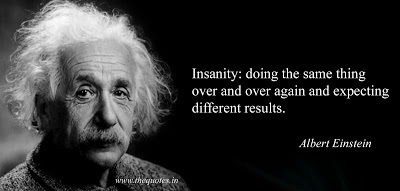
Now let’s take a look at a few specific elements that impact the learning culture of a school where TTWWADI might inhibit growth and progress:
GradingHomeworkObservation and evaluationTeaching to the testProfessional developmentHiring practices Budget preparationPurchasing decisionsInternet filtering Banning or restricting device usePrioritizing athleticsClassroom and learning space design
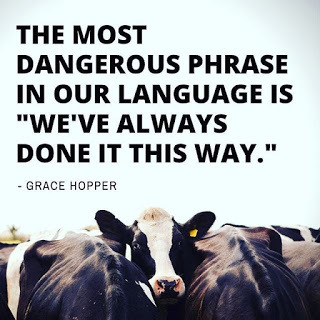
The above list is not exhaustive by any means, but it does provide many opportunities for reflection on whether or not these traditional aspects of education are still persuasive and have remained unchanged. If we continue to do what we have always done in education, then the chances are we will continue to get what we have always gotten. We can ill afford to accept this outcome as changes to the current and future world of work inherent in the 4th Industrial Revolution demand different and better. My point is that the focus should be on taking a critical lens to traditional practices and determine if the way in which they are being implemented is actually in the best interests of a vibrant and prosperous learning culture.
Changes are being made in schools across the world. However, it is vital that we don’t become immune to the fact that a TTWWADI mindset might be entrenched elsewhere in a school, district, or organization beyond our line of sight. As a principal, I dealt with this very issue in the form of the Director of IT. I am not going to mince my words here. The individual in this position was nasty to kids and teachers alike. He was also combative with building administration and got away with it as he was empowered for all the wrong reasons by the superintendent at the time. When it came to Internet filtering, he lived by TTWWADI. Over time my colleagues and I worked with the new superintendent to bring about change to his fixed mindset. He eventually left for another district, and we were fortunate to hire a new person for the position who embodied a growth mindset in this area.
The bottom line is that concerted efforts should always be made to improve existing structures and practices that impact culture. Just because it worked in the past does not mean it is an effective practice in its current form today. All educators now have access to a vast amount of research that can lead to practical changes to the items listed above. There is also a plethora of practical strategies that have led to evidence of improved outcomes available on the Internet and in recently published books. TTWWADI is not always in the best interests of the learners we serve or of the educators that need support to grow and innovate with purpose. To create a thriving culture, some hard battles against tradition need to be fought.
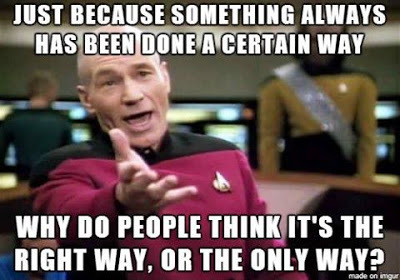
Where might TTWWADI be an impediment to change in your school, district, or organization? What action steps are needed to overcome it?
Many other contributing factors inhibit the pursuit of meaningful change such as time, finances, mandates, and directives. However, there is another significant impediment to change that doesn’t get as much focus as it should and that is tradition. What this then morphs into is a mentality of ”if it’s not broken why fix it”? However, the underlying reason for not changing can be chalked up to TTWWADI – That’s the way we’ve always done it. Tradition, combined with the comfort of the status quo, forms a plausible excuse for not changing. As a result, the learning culture does not evolve or becomes stagnant for both learners and educators. TTWWADI is also a characteristic of a fixed mindset.

Now let’s take a look at a few specific elements that impact the learning culture of a school where TTWWADI might inhibit growth and progress:
GradingHomeworkObservation and evaluationTeaching to the testProfessional developmentHiring practices Budget preparationPurchasing decisionsInternet filtering Banning or restricting device usePrioritizing athleticsClassroom and learning space design

The above list is not exhaustive by any means, but it does provide many opportunities for reflection on whether or not these traditional aspects of education are still persuasive and have remained unchanged. If we continue to do what we have always done in education, then the chances are we will continue to get what we have always gotten. We can ill afford to accept this outcome as changes to the current and future world of work inherent in the 4th Industrial Revolution demand different and better. My point is that the focus should be on taking a critical lens to traditional practices and determine if the way in which they are being implemented is actually in the best interests of a vibrant and prosperous learning culture.
Changes are being made in schools across the world. However, it is vital that we don’t become immune to the fact that a TTWWADI mindset might be entrenched elsewhere in a school, district, or organization beyond our line of sight. As a principal, I dealt with this very issue in the form of the Director of IT. I am not going to mince my words here. The individual in this position was nasty to kids and teachers alike. He was also combative with building administration and got away with it as he was empowered for all the wrong reasons by the superintendent at the time. When it came to Internet filtering, he lived by TTWWADI. Over time my colleagues and I worked with the new superintendent to bring about change to his fixed mindset. He eventually left for another district, and we were fortunate to hire a new person for the position who embodied a growth mindset in this area.
The bottom line is that concerted efforts should always be made to improve existing structures and practices that impact culture. Just because it worked in the past does not mean it is an effective practice in its current form today. All educators now have access to a vast amount of research that can lead to practical changes to the items listed above. There is also a plethora of practical strategies that have led to evidence of improved outcomes available on the Internet and in recently published books. TTWWADI is not always in the best interests of the learners we serve or of the educators that need support to grow and innovate with purpose. To create a thriving culture, some hard battles against tradition need to be fought.

Where might TTWWADI be an impediment to change in your school, district, or organization? What action steps are needed to overcome it?
Published on August 05, 2018 05:44
July 29, 2018
Great Leaders Surround Themselves With Smart People
Leadership is a team sport. It is not about what one person does, but instead the cumulative actions of everyone in an organization. Sure, a leader has to make some pretty important decisions at times that might require bypassing consensus or collaboration, but those are few and far between when you look at the big picture. Success requires broad embracement of ideas where people are motivated to change because they want to, not necessarily because they are forced to. It’s both a two-way street and a give and takes relationship. Effective leaders rely on the expertise of others regardless of where they are in the organizational hierarchy.
The best leaders surround themselves with intrinsically motivated individuals who will not only perform at a high level with little oversight but will also push the leader to reflect and grow continually. One of the most important decisions a leader can make is either through hiring new employees or placing current staff in a position to lead change even if he or she doesn’t have a specific title. Steve Jobs famously said, “It doesn’t make sense to hire smart people and tell them what to do; we hire smart people so they can tell us what to do.” Don’t ever think you have the best ideas or answers because you don’t. If you work with someone who thinks he or she does, then that person is not a leader. Leadership means we must be willing to check our pride at the door if leading change and success are the ultimate goals.
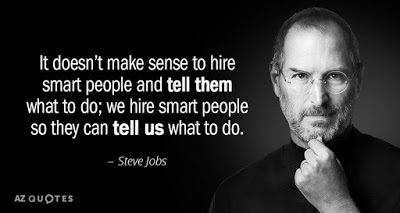
Always try to hire or surround yourself with people that are smarter than you. This should be the most natural part of a two-step process. The next step requires giving up some control and trust. It is this next step where great leaders get out of the way of people who have been empowered for their respective expertise. When I think back to my time as a principal, I tried hard to embody this. When a math position opened many years ago, I hired Kanchan Chellani. She didn’t tell me what to do per se, but little did she know that her actions did. Her ability to effectively implement and model flipped learning in a pedagogically-sound way sent the message to me as a leader that I needed to work better to support the rest of the math department in this area.
Another great example was the hiring of Laura Fleming. I desperately needed an innovative leader in the library who could transform the space in a quick amount of time. She hit the ground running and had full control over her budget and the autonomy to make any decision related to the space that would benefit our learners. Successfully launching a makerspace was what she is known for, but her real impact was how she empowered learners regardless of labels and perceived abilities to find success in ways that they never had. Laura not only transformed the space but her actions and resolve helped to transform the entire learning culture of the school and ultimately the district. Her creation of a micro-credential platform came well before any companies began to monetize them and pushed our teachers to learn in different ways regardless of time or place.
Being told what to do can come in many forms. Laura and Kanchan represented just two of the many teachers that I hired as a principal who indirectly told me what I should do through their actions. There were also may other teacher leaders, as well as members of my admin team, who were not only wicked smart but also leveraged the professional relationship they had with me to guide me in a better direction at times. Depending on others for guidance and wisdom is not a sign of weakness. On the contrary, it a definitive sign of strength. Effective leadership relies on making smart decisions. Make it easy on yourself. Hire or surround yourself with smart people, get out of their way, and don’t be afraid to let them “tell” you what to do. You need these people in your circle if you want to succeed as a leader.
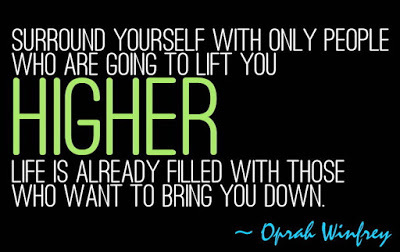
The best leaders surround themselves with intrinsically motivated individuals who will not only perform at a high level with little oversight but will also push the leader to reflect and grow continually. One of the most important decisions a leader can make is either through hiring new employees or placing current staff in a position to lead change even if he or she doesn’t have a specific title. Steve Jobs famously said, “It doesn’t make sense to hire smart people and tell them what to do; we hire smart people so they can tell us what to do.” Don’t ever think you have the best ideas or answers because you don’t. If you work with someone who thinks he or she does, then that person is not a leader. Leadership means we must be willing to check our pride at the door if leading change and success are the ultimate goals.

Always try to hire or surround yourself with people that are smarter than you. This should be the most natural part of a two-step process. The next step requires giving up some control and trust. It is this next step where great leaders get out of the way of people who have been empowered for their respective expertise. When I think back to my time as a principal, I tried hard to embody this. When a math position opened many years ago, I hired Kanchan Chellani. She didn’t tell me what to do per se, but little did she know that her actions did. Her ability to effectively implement and model flipped learning in a pedagogically-sound way sent the message to me as a leader that I needed to work better to support the rest of the math department in this area.
Another great example was the hiring of Laura Fleming. I desperately needed an innovative leader in the library who could transform the space in a quick amount of time. She hit the ground running and had full control over her budget and the autonomy to make any decision related to the space that would benefit our learners. Successfully launching a makerspace was what she is known for, but her real impact was how she empowered learners regardless of labels and perceived abilities to find success in ways that they never had. Laura not only transformed the space but her actions and resolve helped to transform the entire learning culture of the school and ultimately the district. Her creation of a micro-credential platform came well before any companies began to monetize them and pushed our teachers to learn in different ways regardless of time or place.
Being told what to do can come in many forms. Laura and Kanchan represented just two of the many teachers that I hired as a principal who indirectly told me what I should do through their actions. There were also may other teacher leaders, as well as members of my admin team, who were not only wicked smart but also leveraged the professional relationship they had with me to guide me in a better direction at times. Depending on others for guidance and wisdom is not a sign of weakness. On the contrary, it a definitive sign of strength. Effective leadership relies on making smart decisions. Make it easy on yourself. Hire or surround yourself with smart people, get out of their way, and don’t be afraid to let them “tell” you what to do. You need these people in your circle if you want to succeed as a leader.

Published on July 29, 2018 05:25



